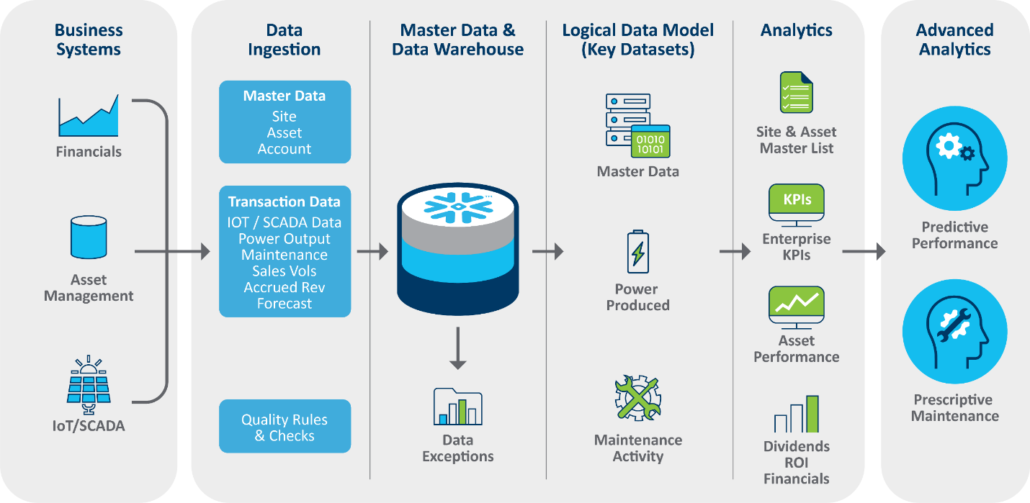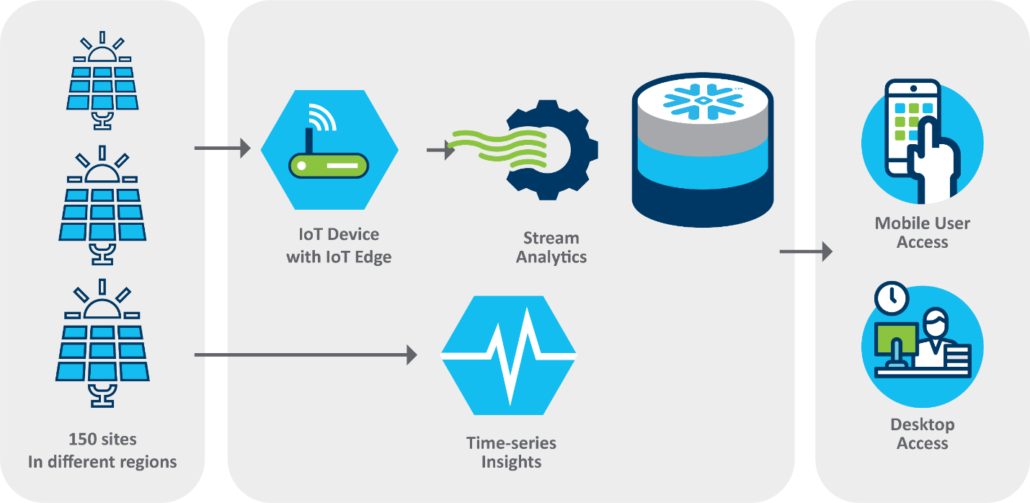A recent Deloitte study of the renewable energy industry found that in the last year, renewables have overtaken coal as a source of power generation in the United States. What’s more, solar and wind combined represented nearly 50% of total U.S. renewable electricity generation.
As the renewable energy industry rises in stature as a competitor to traditional energy companies, it will need to become more vigilant in monitoring its operations, whether at the solar farm or in the back office. To accomplish this, renewable companies will need to apply digital technologies that drive greater efficiency and profitability.
At the center of renewable energy’s digital transformation is data, and more specifically, how it can be applied to improve asset management and reduce operations and maintenance (O&M) costs.
Digital Transformation for Renewable Energy
As the renewable industry looks to transform and evolve, they must continually strive to build a digital foundation to support their information and decision-support needs. The goal of this transformation is to create a more agile organization that can accomplish the following goals:
- Create an empowered, data-driven culture that drives innovation
- Reduce the cost and friction of gathering, finding and managing data
- Reduce manual efforts by automating repetitive tasks
- Optimize asset management and simplify operational complexity
- Embrace advanced analytics and AI to reduce downtime and increase the life and value of equipment
- Efficiently reconcile asset output with what is being consumed
A key challenge for renewable and traditional energy companies is data ingestion and integration. Data must be combined from financial, asset management and IOT/SCADA systems to monitor overall organizational goals. In the past, many energy organizations used “brute force” data integration in conjunction with tools like Excel to give them visibility to operational activity.
Building the Digital Data Foundation
As the industry has matured, however, leading companies have taken a more holistic approach that begins with a focused data management strategy and the right platforms as shown in the following graphic.
With the right platform and architecture in place, data can be cleansed to ensure it is timely and accurate and to quickly surface data exceptions. Key master and transactional data can be curated to expose key data sets such as plant, site, power produced and maintenance activity.
Once this data has been prepared, key performance indicators (KPIs) can be defined to monitor the business. KPIs are critical for monitoring the business, reducing O&M costs, and optimizing asset management. These indicators are typically focused on items such as:
- Plant Availability – The time the plant is available to provide energy to the grid
- Performance Ratio – The relationship between the actual plant energy production and designed target energy production
- Mean time to repair and Mean time to failure
- AC/DC Capacity – Maximum energy generation
Solar, Wind, and the Cloud
With an optimal data foundation, renewable energy companies can then begin the digital transformation journey to provide more advanced analytics such as reducing downtime by scheduling preventative maintenance.
New cloud-based data warehouse solutions offer renewable energy companies an innovative approach to data management, and at an attractive price point over traditional on-prem solutions. For example, Snowflake’s cloud-architected data warehousing platform can scale on demand. More importantly, Snowflake can integrate with powerful business intelligence tools such as Spotfire and Power BI, and it does so without imposing limits on business users.
For renewable organizations looking to maintain a competitive advantage, cloud-architected data management solutions offer tangible benefits, including:
-
- Lower costs
- Simplified architecture
- “Pay as you use” scalability
- Streamlined data integration
- Compatibility with transformational technologies like AI and machine learning
- Simplified integration with BI tools
A renewable industry use case centers on managing larger types of data sets that typically are considered difficult and/or too expensive to manage with traditional database technologies. For example, SCADA data taken from solar panels can be pulled into Snowflake, exposed to analytic tools, and accessed in multiple ways by business users.
Summary
As renewable energy sources like solar and wind grow their share of the global energy mix, it is imperative for them to operate more efficiently—which means embracing digital initiatives in the field and back office, to include new cloud-based data management solutions.
To learn how Stonebridge can help you take advantage of Snowflake’s cloud data warehouse platform to enable your digital transformation journey, contact us.




